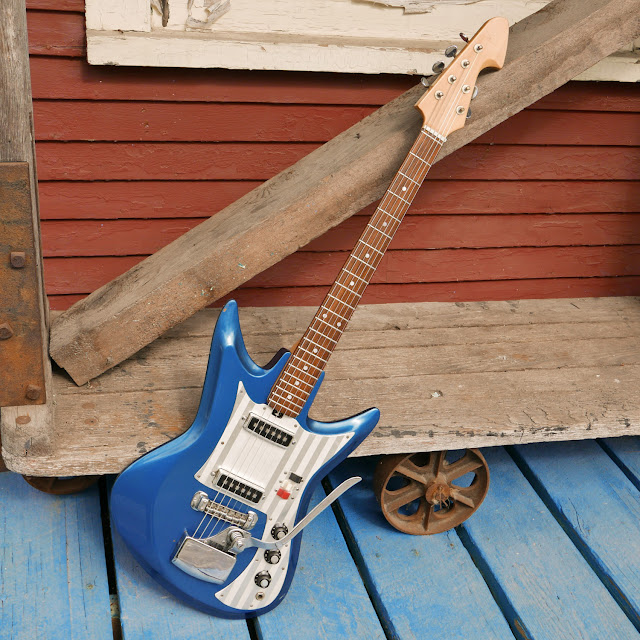1960s Teisco ET-230 Sharkfin Electric Guitar
Double Teisco day? I know -- sheesh! This one is a customer's guitar that was in for some work. This model is not super rare, but it's a better-quality instrument than the average Teisco-made guitar and features a nicely-carved body with a Rickenbacker/Mosrite-style contour to the top edge, a metallic blue finish, and a natural-finished 5-piece maple neck with a modern-style slim-C neck profile, 24 3/4" Gibson-style scale, and 1 5/8" nut width. That last bit is what excites me most about it, as the average Teisco boasts a pretty hefty neck that's not at all ideal, but this one handles like any modern guitar mixed with a hint of '60s Fender influence.
The pickups are also outrageous -- they're quite hot and drive an amp really well. Clean, they sound a lot like a surf pickup in the Jaguar/Mosrite camp, but as soon as you drive the amp at all they begin to spout a darker, rougher sound that's quite unexpected and delicious. The slider switches allow for on/off on each pickup and a lead/rhythm switch that engages a small-value cap to mellow the tone. They're wired out-of-phase in the "both on" position, however, which yields a quiet-but-useful jangly tone that works well for cowboy-chord strumming.
The other bit that I'm always impressed with on nicer-grade Teiscos, however, is how well they're shielded. Not only does this have a thick aluminum pickguard, but everything is properly grounded to it and the casings for the pickups themselves are rather thick and covered entirely on 5 sides. The whammy unit is also well-thought-out and works! It has a pleasant, Bigsby-like action, build, and warble to the sound and the bridge rocks just enough in its mount to keep the guitar in tune while using it.
Work included much cleaning, a fret level/dress, a new set of 46w-10 strings, and a bit of extra setup to dial it in. It's playing perfectly with 1/16" action at the 12th fret overall and the neck is straight with a functional rod.
I love the body shape! The "horns" are rounded-off and pretty dang thing. There's contour everywhere and the metallic blue paint and chrome gives this very much the look of a sports car from the time. It's also lightweight and that makes it a pleasure to hold.
This guitar looks great, now, but was filthy when it came in. It looked like it'd been sitting in a loft for 30 years.
I love the zero fret and the 6+2 headstock. The logo is missing but there's remnants of the adhesive used to fix it.
The rosewood board has about a 12" radius to it and the frets are smaller and low like an old Fender.
Like so many Japanese guitars, the tone control works "backwards" from normal -- 0 is "wide open treble" while 10 is "so dark you can't see."
To get better intonation, I had to angle the bridge a bit. Here you can see the whammy without its cover.
I have no idea how to date this from the serial numbers, but I did some scrounging around on the net and I believe this is a '66 model.

















Comments